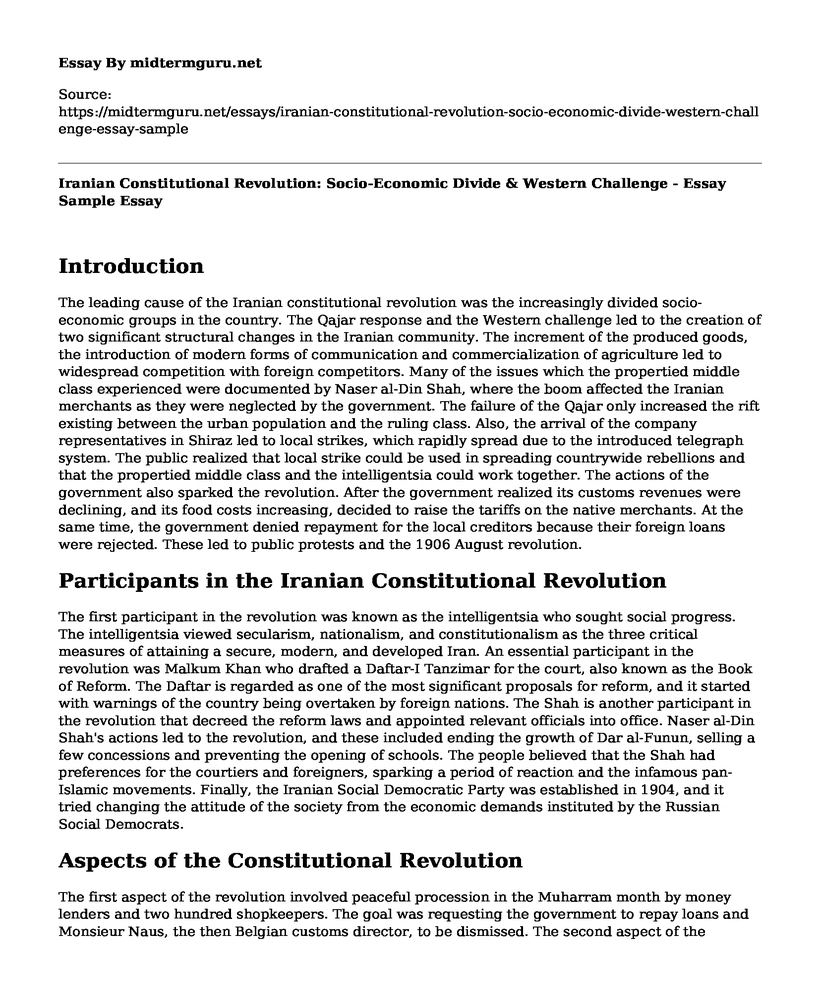Introduction
The leading cause of the Iranian constitutional revolution was the increasingly divided socio-economic groups in the country. The Qajar response and the Western challenge led to the creation of two significant structural changes in the Iranian community. The increment of the produced goods, the introduction of modern forms of communication and commercialization of agriculture led to widespread competition with foreign competitors. Many of the issues which the propertied middle class experienced were documented by Naser al-Din Shah, where the boom affected the Iranian merchants as they were neglected by the government. The failure of the Qajar only increased the rift existing between the urban population and the ruling class. Also, the arrival of the company representatives in Shiraz led to local strikes, which rapidly spread due to the introduced telegraph system. The public realized that local strike could be used in spreading countrywide rebellions and that the propertied middle class and the intelligentsia could work together. The actions of the government also sparked the revolution. After the government realized its customs revenues were declining, and its food costs increasing, decided to raise the tariffs on the native merchants. At the same time, the government denied repayment for the local creditors because their foreign loans were rejected. These led to public protests and the 1906 August revolution.
Participants in the Iranian Constitutional Revolution
The first participant in the revolution was known as the intelligentsia who sought social progress. The intelligentsia viewed secularism, nationalism, and constitutionalism as the three critical measures of attaining a secure, modern, and developed Iran. An essential participant in the revolution was Malkum Khan who drafted a Daftar-I Tanzimar for the court, also known as the Book of Reform. The Daftar is regarded as one of the most significant proposals for reform, and it started with warnings of the country being overtaken by foreign nations. The Shah is another participant in the revolution that decreed the reform laws and appointed relevant officials into office. Naser al-Din Shah's actions led to the revolution, and these included ending the growth of Dar al-Funun, selling a few concessions and preventing the opening of schools. The people believed that the Shah had preferences for the courtiers and foreigners, sparking a period of reaction and the infamous pan-Islamic movements. Finally, the Iranian Social Democratic Party was established in 1904, and it tried changing the attitude of the society from the economic demands instituted by the Russian Social Democrats.
Aspects of the Constitutional Revolution
The first aspect of the revolution involved peaceful procession in the Muharram month by money lenders and two hundred shopkeepers. The goal was requesting the government to repay loans and Monsieur Naus, the then Belgian customs director, to be dismissed. The second aspect of the revolution involved violence, especially in the summer of 1906 after the Shah failed to assemble the house of justice. The issue of contention was the police violence and harassment of citizens. Political organizations were also another important aspect of the constitutional revolution. For example, the National Assembly actions were a catalyst for forming developing civic organizations that strengthened the cause for the rebellion. Some of these organizations include the Society of Theology Students, Society of Guilds, and the Society of Scribes. Additionally, there was the aspect of limiting the power of the monarch through the concepts of medieval kingship and social justice.
Bibliography
Abrahamian, Ervand. "The causes of the Constitutional Revolution in Iran." International Journal of Middle East Studies 10, no. 3 (1979): 381-414. Retrieved from https://mideast-africa.tau.ac.il/sites/humanities.tau.ac.il/files/media_server/mideast_africa/untitled%20folder/3.2Abrahamian-CausesOfConstitutional%20RevolutionPp381-414.pdf
Cite this page
Iranian Constitutional Revolution: Socio-Economic Divide & Western Challenge - Essay Sample. (2023, Jan 31). Retrieved from https://midtermguru.com/essays/iranian-constitutional-revolution-socio-economic-divide-western-challenge-essay-sample
If you are the original author of this essay and no longer wish to have it published on the midtermguru.com website, please click below to request its removal:
- Essay Sample on How the Society Views the Gender
- Letter With Response on Article Perspectives for NATO-Russia Relations - Paper Example
- Luther Was Both a Revolutionary and a Conservative - Paper Example
- Essay Sample on Gender Construction in Kaffir Boy
- Media's Presentation of Mandela in 1985: Analysis of Aljazeera's Beliefs - Research Paper
- Black Arts Movement: Political Activism Through Art - Research Paper
- Revolutionary Changes in Communication: Social Media Sites Explored - Essay Sample







